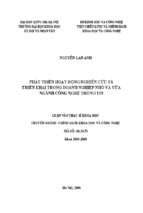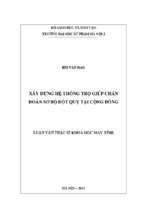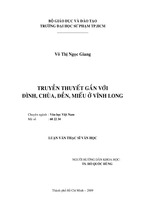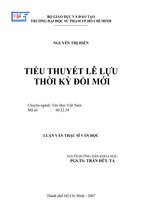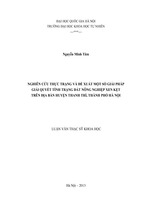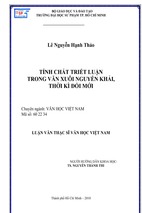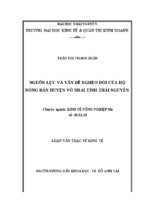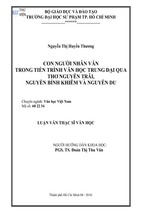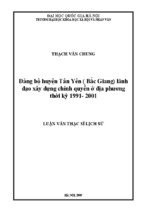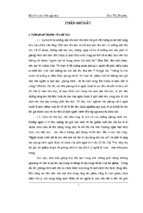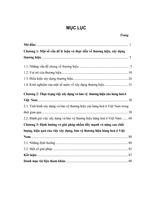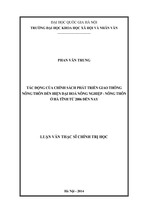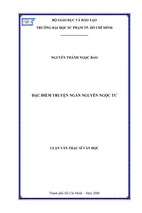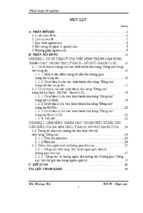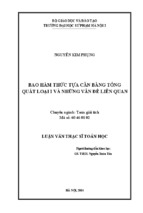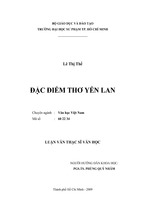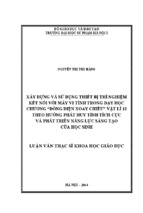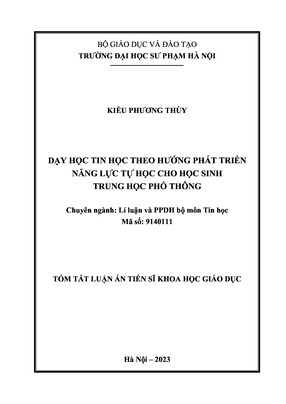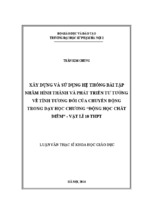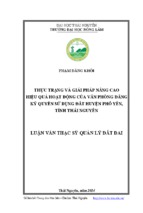FACTORS AFFECTING CITIZENT’S SATISFACTION WITH
THE PUBLIC ADMINISTRATIVE SERVICES OF PUBLIC
ADMINISTRATIVE AGENCIES IN THAI NGUYEN PROVINCE
A DISSERTATION PAPER
Presented to
School of Graduate Studies
Central Philippine University, Philippines
In Collaboration with
Thai Nguyen University, Vietnam
In Partial Fulfillment
Of the Requirements for the Degree
DOCTOR OF MANAGEMENT
TRAN PHAM VAN CUONG
MAY 2020
i
DECLARATION
I pledge that this is my own research. The data stated in the thesis is true, all
citations are indicated origin. The research results of the dissertation were published in the
scientific journal, not identical with any other works.
PhD student
Trần Phạm Văn Cương
ii
LỜI CAM ĐOAN
Tôi xin cam đoan đây là công trình nghiên cứu của riêng tôi. Các số liệu
nêu trong luận án là trung thực, mọi trích dẫn đều được chỉ rõ nguồn gốc.
Những kết quả nghiên cứu của luận án đã được tác giả công bố trên tạp chí
khoa học, không trùng với bất kỳ công trình nào khác.
Tác giả luận án
Tran Pham Van Cuong
iii
ACKNOWLEDGEMENT
The author wishes to convey the gratitude to the following persons who
wholeheartedly devoted and helped make this piece of work a reality:
To Associate Prof. Do Anh Tai and PhD. Pham Van Hanh for his advices,
guidance, supervision, suggestions and precious time in enthusiastically reading and
checking the manuscript, providing the author useful materials;
To the leadership of International Cooperation Center for Training and Study
Abroad and their staff for their enthusiasm to support executive for the participants
completed the study program.
To the faculties and researchers of Thai Nguyen University of Economics and
Business Administration and the respondents of the study, for their active involvement and
cooperation which made the conduct of the study possible;
To my family and friends for their love and support in one way or another, and to
all who have contributed to make this study a success.
Thank you so much!
Thai Nguyen, May 2020
PhD student
Tran Pham Van Cuong
iv
LỜI CẢM ƠN
Tác giả mong muốn truyền tải lòng biết ơn đến những người sau đây đã hết lòng
cống hiến và giúp đỡ tác giả trở thành hiện thực:
Tôi xin bày tỏ lòng biết ơn sâu sắc nhất tới PGS.TS Đỗ Anh Tài và TS. Phạm
Văn Hạnh - người hướng dẫn khoa học đã tận tình giúp đỡ và định hướng để tôi hoàn
thiện Luận án.
Trong quá trình học tập và nghiên cứu, tôi cũng đã nhận được sự hỗ trợ và giúp đỡ
tận tình từ Ban Giám hiệu, Lãnh đạo và cán bộ của Trung tâm Hợp tác Quốc tế về Đào
tạo và Du học, Lãnh đạo Khoa Kinh tế cùng toàn thể các thầy cô giáo tại Trường Đại học
Kinh tế và Quản trị Kinh doanh - Đại học Thái Nguyên và Đại học Central Philippine, tôi
xin ghi nhận và chân thành cảm ơn.
Cuối cùng, tôi xin bày tỏ lòng biết ơn tới đồng nghiệp, bạn bè và gia đình đã luôn
kịp thời động viên, chia sẻ và tạo điều kiện tốt nhất giúp tôi hoàn thành luận án của mình.
Tác giả Luận án
Trần Phạm Văn Cương
v
TABLE OF CONTENTS
CAMPAIGNS ..................................................................... Error! Bookmark not defined.
LỜI CAM ĐOAN .................................................................................................................ii
ACKNOWLEDGEMENT..................................................................................................iii
LỜI CẢM ƠN...................................................................................................................... iv
LIST OF TABLES .............................................................................................................vii
CHAPTER 1: INTRODUCTION....................................................................................... 1
1.1. Background and Rationale of the Study ......................................................................... 1
1.3. Theoretical Framework ................................................................................................... 7
1.4. Conceptual Framework ................................................................................................... 9
1.6. Significance of the Study .............................................................................................. 18
1.7. Scope of this study ........................................................................................................ 18
CHAPTER 2: LITERATURE REVIEWS ...................................................................... 20
2.1. Public Service ............................................................................................................... 20
2.2. Citizen‟s Satisfaction .................................................................................................... 23
2.3. Service Quality ............................................................................................................. 28
2.4. Quantitative Approaches to Measuring Service Quality............................................... 34
2.5. Service Quality in Public Sector Organizations ........................................................... 36
2.6. Factors Affecting Public Service Quality and Citizen‟s Satisfaction ........................... 39
2.7. Related Studies ............................................................................................................. 43
CHAPTER 3: METHODOLOGY ................................................................................... 48
3.1. Research Design ........................................................................................................... 48
3.2. Population ..................................................................................................................... 48
3.3. Population, Sample Size, Sampling Techniques .......................................................... 48
3.4. Data Collection Procedures .......................................................................................... 51
3.5. Measurement ................................................................................................................. 51
3.6. Data Analysis .................................................................................................................. 54
3.7. Sample Profile............................................................................................................... 55
3.8. Scale Descriptive Analysis ........................................................................................... 56
3.8.1. Item Descriptive Analysis for Servant‟s Attitude and Responsibility ....................... 56
3.8.2. Item Descriptive Analysis for Servant‟s Competency Scale ..................................... 56
vi
3.8.3. Item Descriptive Analysis for Cost Scale .................................................................. 58
3.8.4. Item Descriptive Analysis for Time Scale ................................................................. 58
3.8.5. Item Descriptive Analysis for Facilities Scale ........................................................... 59
3.8.7. Item Descriptive Analysis for Satisfaction Scale ...................................................... 60
3.8.8. The Summary of Variable Descriptive Analysis ....................................................... 61
3.9. Scale Purifications ........................................................................................................ 62
4.1. Measurement Model ..................................................................................................... 70
4.2. Convergent and Discriminant Validity of Scale ........................................................... 79
4.3. The Analysis of Factors Affecting Citizen‟s Satisfaction ............................................ 81
4.4. Hypothesis Testing ....................................................................................................... 84
CHAPTER V: SUMMARY, CONCLUSIONS AND RECOMMENDATIONS ......... 87
5.1. Summary and Conclusion ............................................................................................. 87
5.2. Policy Recommendations ............................................................................................. 90
5.2.1. Improve Servants‟ Attitude and Responsibility When Contacting with Citizens ..... 90
5.2.2. Improve Servants‟ competence .................................................................................. 91
5.2.3. Improve the service procedures to save the time and cost of citizens ....................... 92
5.2.4. Improve the facilities to support public service providing ........................................ 93
5.2.5. Supervising the delivery of public administrative services ....................................... 94
5.2.6. Improve the Public Service Quality Management ..................................................... 95
5.3. Limitations and Suggestions for Future Research ........................................................ 96
REFERENCES................................................................................................................... 97
APPENDIX ....................................................................................................................... 102
vii
LIST OF TABLES
Table 3.1. List of Items ........................................................................................................ 52
Table 3.2. Characteristics of Sample ................................................................................... 55
Table 3.3. Descriptive Analysis for Servant‟s Attitude and Responsibility Scale .............. 56
Table 3.4. Descriptive Results for Servant‟s Competency Scale ........................................ 57
Table 3.5. Descriptive Results for Service Cost Scale ........................................................ 58
Table 3.6. Descriptive Results for Time Scale .................................................................... 58
Table 3.7. Descriptive Results for Facility Scale................................................................. 59
Table 3.11. Item Purification for Citizens‟ Satisfaction Scale ............................................ 62
Table 3.12. Item Purification for Servant‟s Attitude and Responsibility Scale ................... 63
Table. 3.13. Item Purification for Servant‟s Competence Scale .......................................... 64
Table 3.15. Item Purification for Time Scale ...................................................................... 66
Table 3.16. Item Purification for Facility Scale................................................................... 67
Table 3.17. Item Purification for Procedure Scale............................................................... 67
Table 3.18. Scale Reliability ................................................................................................ 69
Table 4.1. Measurement Model Results for Citizens‟ Satisfaction Scale ............................ 71
Table 4.2. Measurement Model Results for Servant‟s Attitude and Responsibility Scale .. 72
Table 4.3. Measurement Model Results for Servant‟s Competence Scale .......................... 73
Table 4.4. Final Measurement Model Results for Servant‟s Competence Scale ................. 74
Table 4.5. Measurement Model Results for Reasonable Cost Scale ................................... 75
Table 4.6. Measurement Model Results for Service Time Scale......................................... 76
Table 4.7. Measurement Model Results for Facility Scale .................................................. 77
Table 4.8. Measurement Model Results for Procedure Scale .............................................. 78
Table 4.9. Final Measurement Model Results ..................................................................... 79
Table 4.10. Construct Correlation Matrix ............................................................................ 81
Table 4.11 The regression results ........................................................................................ 82
Table 4.12 Model Summary ................................................................................................ 83
Table 4.12. Summary of Hypothesis-Testing Results ......................................................... 86
viii
LIST OF FIGURES
Figure 1.1. Conceptual Framework ................................................................................... 11
LIST OF ABRIVIATIONS
OSS
One - stop shop
SERVQUAL
Service Quality
SERVPERF
Service performance
SAT
Citizen‟s Satisfaction
ATT
Governmental Servant‟s Attitudes
COM
Governmental Servant‟s Competency
COST
Cost for public service
TIME
Time for receiving public services
FACT
Service facilities
PRO
Procedures
NPM
New Public Management
KMO
Kaiser-Meyer-Olkin-Kriterium
ANOVA
Analysis of Variance
GFI
Goodness-of-fit Index
AGFI
Adjust Goodness-of- fit Index
CFI
Comparative Fit Index
RMSEA
Root Mean Square Error of Approximation
EFA
Exploratory Factor Analysis
CFA
Confirmatory factor analysis
RMR
Standardized Root Mean Square Residual
1
CHAPTER 1: INTRODUCTION
1.1. Background and Rationale of the Study
Public sector reform movements around the world in the 1990s, codified as New Public
Management (NPM), have been aimed at „fostering a performance- oriented culture in a less
centralized public sector‟ (OECD, 1995). Such reforms are characterized by key elements
including increase in the use of markets and competition providing public services and in
emphasis on performance, outputs and customer orientation. One consequence of these reforms
has been the reorientation of public services towards their consumers. This has brought with it
pressure for better public service quality, from service users as their needs change and their
expectations rise in respect of how well services can be performed (Flynn, 1995).
In recent years, the reform of state administration in Vietnam has achieved significantly
positive results. Decree 38-CP of the Vietnamese Government dated 04.05.1994 has marked
an important step in the development process: implying the administrative procedures and
improving the relationship between administrative agencies and citizens. The regulations for
implementing the "one- stop shop" in the state administrative agencies, issued with the
application of quality management system in operation of the administrative agencies
initially, are efficient. On 22/6/2007, the Vietnamese Prime Minister had Decision No.
93/2007/QD-TTg on promulgating the regulations to implement OSS at the local
administrative agencies in order to further improve the implementation of "one stop shop" to
suit each type of administrative procedures. The government has been implementing projects
on not only training and retraining to enhance the capacity of staff, especially those who
directly communicate and solve the requirements of citizens but also modernizing the state
administration as well as accelerating the construction of spacious administrative offices.
Public administration reforms include organizational reform, reform of cadres and civil
servants training and financial reform. These are the internal problems of public
2
administration. But the reform of administrative institutions, including administrative
procedures, is a non-state issue, but also related to the lives of the social classes. This is the
reason why the Vietnamese State has to pay more attention to the reform of administrative
procedures in order to meet the service requirements, serve the society and improve the
efficiency and effectiveness of the house management in the context of economic
transformation.
Thai Nguyen is a mountainous province located in the northern of Vietnam. In recent
years, the business investment environment of Thai Nguyen province has been constantly
improved. The PCI of the province for 3 consecutive years (2014, 2015, 2016) ranked among
the 10 provinces with the highest PCI in the country, many big investors chose Thai Nguyen
as the destination to build their headquarters. , such as Sam Sung Group, Vingroup; In 2018,
Thai Nguyen ranked 18/63 provinces, ranked second in the ranking of PCI index of Northern
mountainous provinces, after Lao Cai. In 2019, the rank of Thai Nguyen still at 18/63
provinces. In order to improve the investment environment, Thai Nguyen needs to improve
the provincial competitiveness index. In which administrative procedure reform and citizen's
satisfaction are important to contribute to improving the investment environment.
Up to this point, Thai Nguyen province is ranked at 7th place on the PCI rankings in
the country, continuing to be in the top 10 rankings of provinces and cities with the best
operating quality and standing at 2nd place in the Northern mountainous provinces with a total
of 61.21 points. To achieve this result, the entire political system has taken steps to direct and
implement drastically and synchronously many solutions, especially tax administrative
reform, customs, insurance, construction licensing and land investment procedures, to
strongly attract domestic and international investment. Administrative reform has created
favorable conditions for the production and business activities of organizations and
3
individuals, contributing to job provision for laborers, boosting the province's economic
growth rate (up 25% Per annum) and raising the GDP per capita.
The provincial People's Committee has implemented the one-stop, one-stop shop
mechanism to receive and return results of handling administrative procedures in nearly
100% of state administrative agencies in the locality. The province also organized the
Steering Committee for Administrative Procedure Reform (PAR Steering Committee) to
strengthen measures to improve and improve the administrative procedure reform index
(PAR INDEX), the provincial administrative and public administration performance
index (PAPI); Announcing the results of the survey on the level of satisfaction of people
with regard to the service of state administrative agencies in all communes and wards in
the province.
The clearest evidence for the PCI results in recent years is that Thai Nguyen province
has had a remarkable growth in socio-economic development, the economic growth rate
always ranks among the group of provinces with only The number increased (in 2018, the
total budget revenue reached over VND 15,000 billion). Thai Nguyen is an attractive
environment to attract many investors and large corporations with financial potential such as
Samsung Group, Vingroup, T&T, FLC; Masan and FDI businesses; Since the 2018
Investment Promotion Conference, so far, it has attracted 64 projects of 44 investors, with a
total registered investment capital of about VND 115,670 billion. The average economic
growth rate (GRDP) of Thai Nguyen in recent years has reached over 12%, one of the top
nationwide; The state budget revenue in the first 6 months of 2019 reached VND 7,325
billion, equaling 48.8% of the yearly estimate, up 5.1% over the same period, striving to
balance revenue and expenditure by 2020 (Thai Nguyen Statistic Yearbook, 2019).
In addition to the achieved results, the province's business and investment environment
still reveals some limitations that need to be overcome soon, such as: The stability of the PCI
4
component indicators is not high, the collection investment attraction has no long-term
strategy; reform of administrative procedures is still slow and not really effective, the
mechanism of coordination among levels and sectors in guiding, urging, inspecting,
monitoring and solving difficulties and obstacles With the low-yielding projects, there are still
harassment of cadres, civil servants and officials in handling jobs for people and businesses,
infrastructure of some industrial parks and clusters have not been invested. synchronous, not
yet created a lot of land for investment, development .
At present, the administrative procedures still exist some common phenomena such as
cumbersome, overlapping, rigid. In addition, the issuance of administrative procedures at
some time, even where arbitrary, including the issuance of "sub-license"; Procedures for
resolving procedures are still the phenomenon of rights, harassment, delays in the way of
"people need, not in a hurry" and still through many intermediate stages; unclear.
With the goal of providing better administrative services to citizens and organizations,
leaders of Vietnamese government have implemented policies besides conducting reforms to
strengthen the investment attraction and improve the satisfaction of the people in provinces.
Citizen's satisfaction is the most honest and accurate measure of every administrative
reform effort. This will not only fundamentally change the nature of the reform but also
establish a higher accountability regime for administrative officials. Therefore, in order to
improve provincial competitiveness, it is important to continue to accelerate the reform of
administrative procedures at the concerned departments and branches at all levels, ensuring
quick, neat and favorable conditions. Maximum benefit for organizations and individuals,
ensuring 100% of the dossier received at the one-stop section. At the same time tighten
discipline, administrative discipline, improve the responsibility of each civil servant and
official in handling administrative procedures; elaborate internal procedures for settling
administrative procedures on natural resources and environment at provincial, district and
5
commune levels according to the Government's regulations; to build synchronously the land
database in the whole province in association with adjusting land fluctuations and granting
land use right certificates; invest in building and implementing a modern one-stop shop, onestop shop system ... From improving people's satisfaction, the provincial competitiveness
index will also be improved. From there, attract investment capital into Thai Nguyen
province.
In recent years, the province has had many advocates of administrative procedure
reforms to attract investment and improve the satisfaction of the people. However, the reform
of administrative procedures has not achieved the desire and satisfation of citizens with the
government agencies. There is a large number of published studies on the quality of public
administration services; however, no study on the quality of public administration services
and citizen‟s satisfaction at the Thai Nguyen Province.
Previous studies about citizens‟satisfaction also refered to some components of
administrative service. However, there is no study that focus on citizens‟ satisfaction in Thai
Nguyen province.
Studying the factors affecting the satisfaction of citizens and organizations with the
service of state administrative agencies is a necessary task, not only helping state
administrative agencies to grasp the perception of citizens, organizations on the quality of
handling administrative procedures; The requirements and expectations of people and
organizations for the quality of handling administrative procedures so that state administrative
agencies can work out appropriate solutions to improve the quality of handling administrative
procedures, Improving people's and organizations' satisfaction, contributing to the
development of an administrative service but also creating conditions and opportunities for
people and organizations to contribute their comments and supervise the process of
6
construction and organization. Implementing policies, especially in the field of providing
public services to people and organizations.
When public administration services are not improved, it is annoying for people to
reduce investment attraction in Thai Nguyen province. There are many investors who intend
to come to Thai Nguyen to invest but they have moved elsewhere because the procedure is
too complicated. This is the reason why author choose to do this research.
In Thai Nguyen, although administrative reform has been implemented for many
years, but in general still complicated and troublesome for citizens. The rate of paperwork on
time has increased, but the status of the dossier is delayed. In addition to the objective reasons
of procedural process, due to the limited capacity of professional cadres and civil servants,
some specialized agencies still have the status of a number of cadres and civil servants who
are ignorant of their responsibilities, have not fulfilled all responsibilities in settling
troublesome and annoying jobs for the citizens.
In addition, some previous studies has identified factors affecting people‟s satisfaction
with public administrative services, however, no study has identified the factors affecting
people satisfaction based on service quality management approach. This study goes further
when determine the factors according to the service quality management approach, as well as
the typical factors of Vietnam's public administration.
1.2. Objectives of the Study
In general, this study identified factors affecting citizen‟s satisfaction with public
services of administrative agencies in Thai Nguyen province, and proposed some policy
implications for Thai Nguyen government to increase citizen‟s satisfaction in Thai Nguyen
province.
7
Specifically, the research objectives which correspond to therefore mentioned issues
are shown below.
1) Systematizing the theories on factors that affect citizens‟ satisfaction with public
administrative service.
2) Determine the factors that significantly affect citizen‟s satisfaction with public
administrative service of public administrative agencies in Thai Nguyen province.
3) To recommend some policy suggestions to increase the citizens‟ satisfaction with
public administrative services of administrative agencies in Thai Nguyen province.
1.3. Theoretical Framework
Appraisal theories
Appraisal theories of emotion are theories that state that emotions result from people's
interpretations and explanations of their circumstances even in the absence of physiological
arousal (Aronson, 2005). There are two basic approaches; the structural approach and process
model. These models both provide an explanation for the appraisal of emotions and explain in
different ways how emotions can develop. In the absence of physiological arousal we decide
how to feel about a situation after we have interpreted and explained the phenomena. Thus the
sequence of events is as follows: event, thinking, and simultaneous events of arousal and
emotion. Social psychologists have used this theory to explain and predict coping mechanisms
and
people's
patterns
of
emotionality.
By
contrast,
for
example, personality
psychology studies emotions as a function of a person's personality, and thus does not take
into account the person's appraisal, or cognitive response, to a situation
Expectancy Theory
Expectancy theory (Vroom, 1964) recommends that an individual will choose to
perform or act in a particular way because they are inspired to select a precise action over
8
other actions due to what they accept the result of that selected performance will be. Because
of the desirability of the outcome, the behavior has been selected. By applying expectancy
theory, the relationship between service quality and customer satisfaction will be explained.
Social Exchange Theory
According to social exchange theory (Blau, 1964), individual would adopt exact
behaviors based on the norm of reciprocity to express appreciation to the group or business.
Within this situation, individual perform in a assured way and they understand the sense of
the activities and they form their behavior to achieve goal and bring benefits for them to adopt
a specific behavior to express the gratitude to the industry. By applying social exchange
theory, the relationship between customer satisfaction, tourist loyalty and word of mouth will
be explained.
Disconfirmation Theory
A discussion on customer satisfaction and customer expectations cannot be complete
without discussing the disconfirmation theory. The disconfirmation theory stands out as the
primary foundation for satisfaction models in marketing literature (Churchill and Surprenant,
1982; Oliver, 1980).
According to this theory, satisfaction is determined or measured by the discrepancy
between perceived performance and cognitive standards such as expectations and desires
(Khalifa and Liu, 2003). Customers or clients expectations can be defined as customer‟ s
partrial beliefs about a product or service (Mckinney et al, 2002).
According to Zeithaml and Berry (1988), expectations can be viewed as predictions
made by consumers about what is likely to happen during impending transaction or
exchange.Perceived performance on the other hand is customers‟ perception of how product
or service performance fulfills their needs, wants and desire (Cadotte et al, 1987).
9
Perceived quality is the customer‟ s judgement about an entity‟ s overall excellence
or superiority (Zeithaml, 1988). Disconfirmation is therefore defined as the customer‟ s
subjective judgements resulting from comparing their expectations and their perceptions of
performance received (Mckinney et al, 2002; Spreng et al, 1996). The disconfirmation theory
states that satisfaction is affected by the intensity (or size) and direction (positive or negative)
of the gap (disconfirmation) between expectations and perceived performance.
1.4. Conceptual Framework
The provision of public administrative services is always linked to the authority and
operation of state administrative bodies - with legal power - in the exercise of the legal rights
and obligations of organizations and citizen. Activities such as the granting of permits, birth
certificates, notarization, civil status ... Legal administrative jurisdiction is expressed in the
form of public administrative services to address the rights and legitimate interests of the
human resource. It is the activity of serving citizens from the State administrative agencies.
These activities cannot be delegated to any organization other than a public administrative
agency and will only be valid when administered by a public administrative agency. Thus, the
need to provide public administrative services to the public (consumers) is not a requirement
of their own but derives from the compulsory nature of the state. The State obliges and
encourages people to implement these regulations in order to ensure social order and safety
and perform the function of managing all aspects of social life.
The prior studies focused the components affecting citizens with public administrative
services which are: Reliability, Capacity of civil servants, Serving attitude, Empathy,
Facilities and the Process of delivery. In fact, citizens must pay fee for using some public
administrative services at the grassroots level (but some no payment). Citizens won't be
satisfied if they have to wait for their turn or spend much time for settling their documents.
Therefore, time and cost of using public administrative services should be considered. It is
10
also possible that the citizens' perception of time and cost of public administrative services
would influence their satisfaction of the public administrative services.
The prior studies concentrated the components affecting citizens with public
administrative services which are: Reliability, Capacity of civil servants, Serving attitude,
Empathy, Facilities and the Process of delivery. In fact, citizens must pay fee for using some
public administrative services at the grassroots level (but some no payment). Citizens won't
be satisfied if they have to wait for their turn or spend much time for settling their documents.
Therefore, time and cost of using public administrative services should be considered. It is
also possible that the citizens' perception of time and cost of public administrative services
would influence their satisfaction of the public administrative services. By qualitative
research methods based on prior studies, combining with legal writings and the actual status
of public administrative services delivery at the grassroots level, the author adjusted and
supplemented the instrument to get components affecting the quality of public administrative
services. They are: (1) Reliability, (2) Capacity of civil servants, (3) Civil servants‟ serving
attitude, (4) Empathy, (5) Facilities, (6) Process of delivery and (7) Time and Cost. Thus, a
research model is proposed to discuss the possible relationships among the citizens‟
perception and their satisfaction.
By qualitative research methods based on prior studies, combining with legal writings
and the actual status of public administrative services delivery at the grassroots level, the
author adjusted and supplemented the instrument to get components affecting the quality of
public administrative services. They are: (1) Servant‟s Competency, (2) Servant‟s Attitude,
(3) Procedures, (4) Cost, (5) Time, (6) Service Facilities. Thus, a research model is proposed
to discuss the possible relationships among the citizens‟ perception and their satisfaction. The
proposed model also had some changes comparative to SERVQUAL and SERVPERF model.
11
Figure 1.1. Conceptual Framework
Dependent Variables
Independent Variables
Servant's Competency
Relationship
Servant's Attitude and
Responsibility
Citizen’s satisfaction
Procedures
Cost
Time
Service Facilities
From the study of Zeithalm and Bitner (2008:85), “Service quality is a focused
evaluation that reflects the customer‟s perceptions of specific dimensions of quality:
reliability, responsiveness, assurance, empathy and tangible”. However, in public service
context, service quality may be affected by some other factors. This study developed some
other dimensions different from those of Zeithalm and Bitner. These factors were as
following:
Servant’s Attitudes and Responsibility
Servant‟s attitudes affect public service quality. When Servants have suitable attitudes
with citizens, they may easily accept some inconvenience in service process. These are
officials and specialists directly handling the dossiers and communicating with citizens who
have improper attitude will create bad image in the eyes of the citizens, reducing the
satisfaction of the citizens with the authorities. Friendly, sincere, courteous, sympathetic,
sharing ... in the process of handling work, reception of civil servants, officials greatly affect
the satisfaction of the people. Civil servants also need to behave confidently, properly, in
accordance with code of conduct. When people communicate with each other, the urge to
- Xem thêm -


